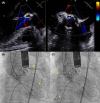Acute decompensated heart failure after transcatheter aortic valve implantation: A case report
- PMID: 37484748
- PMCID: PMC10362099
- DOI: 10.1002/ccr3.7597
Acute decompensated heart failure after transcatheter aortic valve implantation: A case report
Abstract
Transcatheter aortic valve implantation (TVAI) is a widely used treatment modality for severe aortic stenosis. The complication rates of the procedure have gradually decreased over time, owing to the improvements in procedural skills and development of TVAI devices. However, several rare but serious complications can still occur after TAVI. We recently encountered acute decompensated heart failure as a rare and fatal complication of TAVI and would like to share our experience.
Keywords: acute decompensated heart failure; left ventricular stunning; stress‐induced cardiomyopathy; suicide left ventricle; transcatheter aortic valve implantation.
© 2023 The Authors. Clinical Case Reports published by John Wiley & Sons Ltd.
Conflict of interest statement
All authors have no potential conflicts of interest to disclose.
Figures




References
-
- Otto CM, Nishimura RA, Bonow RO, et al. 2020 ACC/AHA guideline for the management of patients with valvular heart disease: executive summary: a report of the American College of Cardiology/American Heart Association joint committee on clinical practice guidelines. Circulation. 2021;143(5):e35‐e71. - PubMed
-
- Grube E, Sinning JM. The "Big Five" complications after transcatheter aortic valve replacement: do we still have to be afraid of them? JACC Cardiovasc Interv. 2019;12(4):370‐372. - PubMed
-
- Fabbro M, Goldhammer J, Augoustides JG, et al. Case 1‐2016 problem‐solving in transcatheter aortic valve replacement: cardiovascular collapse, myocardial stunning, and mitral regurgitation. J Cardiothorac Vasc Anesth. 2016;30(1):229‐236. - PubMed
-
- Harhash A, Koulogiannis KP, Marcoff L, Kipperman R. Takotsubo cardiomyopathy after transcatheter aortic valve replacement. JACC Cardiovasc Interv. 2016;9(12):1302‐1304. - PubMed
Publication types
LinkOut - more resources
Full Text Sources

